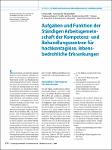Aufgaben und Funktion der Ständigen Arbeitsgemeinschaft der Kompetenz- und Behandlungszentren für hochkontagiöse, lebensbedrohliche Erkrankungen
The goals and structure of the Permanent Working Group of Medical Competence and Treatment Centers for highly contagious, life-threatening diseases
Gottschalk, René
Grünewald, Thomas
Biederbick, Walter
Die Einschleppung von Tropenkrankheiten nach Deutschland wird durch den zunehmenden Ferntourismus und durch die Globalisierung wirtschaftlicher Aktivitäten zu einem immer häufiger auftretenden Problem für das Gesundheitswesen. Die vernetzte Struktur landkreis- und teilweise länderübergreifender Kompetenzzentren für hochkontagiöse lebensbedrohliche Infektionskrankheiten hat sich bewährt und gezeigt, dass durch die Verknüpfung von öffentlichem Gesundheitsdienst (ÖGD), klinischer Versorgung, laborgestützte Spezialdiagnostik, Feuerwehr/Rettungsdienst und Krankenhaushygiene auch auf zunächst unerwartete infektiologische Situationen schnell und professionell reagiert werden kann. Mit diesen Netzwerken, die sich in der Ständigen Arbeitsgemeinschaft der Kompetenz- und Behandlungszentren (StAKoB) zusammengeschlossen haben, verfügt Deutschland derzeit über ein weltweit einzigartiges Instrument zur Behandlung hochinfektiöser, lebensbedrohlicher Infektionskrankheiten. Im vorliegenden Beitrag werden die Ziele und die Struktur der StAKoB dargestellt. The introduction of tropical diseases into Germany is becoming a more and more frequent public health problem due to increasing long distance travel and the globalization of economic activities. A network of centers of excellence for imported, highly contagious diseases has proven efficient and shown that the linking of public health service, clinical care, laboratory-based special diagnostics, ambulance service, and hospital hygiene can react quickly and professionally in even unexpected situations in clinical infectiology. These networks joined forces in the “Permanent Working Group of the Medical Competence and Treatment Centers“ (Ständigen Arbeitsgemeinschaft der Kompetenz- und Behandlungszentren, StAKoB). Not only in Germany but also worldwide, the StAKoB is a unique system for the treatment of imported highly contagious diseases. The goals and structure of the StAKoB are presented in this article.
No license information

